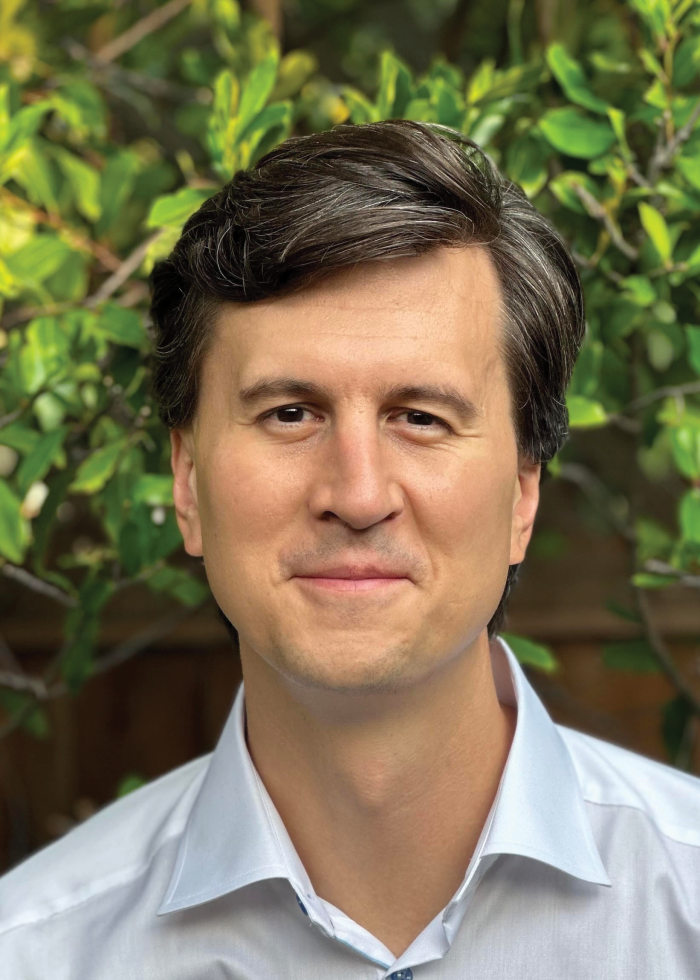Jan Sramek has been making the rounds.
Sramek, 36, is founder and CEO of California Forever, which seeks to build a large new community in Solano County. While cities or large unincorporated communities have been built from scratch before in California and elsewhere, what makes this potential metropolis unusual — and has stirred public controversy — are the people behind it and its backstory.
In late August, The New York Times broke the news that another company Sramek is connected to, Flannery Associates, had quietly spent more than $800 million provided by Silicon Valley giants like LinkedIn co-founder Reid Hoffman and Laurene Powell Jobs, who is the widow of Apple co-founder Steve Jobs, to purchase land to build the community.
The mysterious land purchases had previously stirred concerns that foreign investors were intentionally buying land near Travis Air Force Base. Beyond this, there are several pending lawsuits related to the potential community and concerns about everything from possible traffic impacts to where this community will get its water.
So in recent months, Sramek has been meeting with elected officials and other local leaders whose buy-in he will need for his proposed community to get built.
“I think that the people we talked to understand why we took the long-term approach, acquired the property and then introduced the idea,” Sramek says.
Sramek touts a walkable community similar to American cities of old, with nearby retail and ample green space at the outskirts. The question is if enough of the broader region will ultimately believe in Sramek’s vision for it to get built.
Willing to talk
Among local leaders, Sramek could do worse for potential allies than Ron Kott.
Kott is mayor of Rio Vista, a city of around 10,000 people nestled at the apex of the Sacramento River Delta and the northeast reaches of the San Francisco Bay Area. If California Forever’s community gets built, it could be somewhere among 60,000 acres of land purchased by Flannery Associates that aren’t far away.
Still, Kott says he enjoyed meeting with Sramek in September and has also had a three-hour sitdown with some planners from the project and Rio Vista city staff.
“I liked him,” Kott says. “I look forward to having continued discussions with them. I think we can work with them.”
Bill Emlen, county administrator for Solano County, says he’s been in one meeting with people connected to the project and that county staff have held one or two other meetings with them.
To say Sramek’s proposed community is in its early stages seems like an understatement. There’s been no environmental impact report or concrete plans submitted beyond public renderings that show a walkable, idyllic town.
“We’re basically kind of waiting to see what they come in with,” Emlen says. “We are treating this as real. Obviously, they’re investing money into it, so we know they’re likely to come forward with something. We just don’t know exactly what the scope of it is right now.”
In Suisun City, another Solano city close to California Forever’s land, there is something of a political divide.
Mayor Pro Tempore Princess Washington appeared remotely, along with Fairfield Mayor Catherine Moy, during a Nov. 2 strategy meeting at a local Black Bear Diner for a coalition opposed to the project. Washington, who heads up the Solano Orderly Growth Committee, refused to meet with California Forever, telling Comstock’s, “I can’t see anything at this time that I think would be for me to support it.”
Suisun City Mayor Alma Hernandez, though, recently sat down with Sramek for 45 minutes in her offices at city hall. Asked if she trusted Sramek, Hernandez said she didn’t know.
“I’ve only met him one time and prior to this meeting, I honestly had not heard of him,” Hernandez says. “But I will say that it’s an individual I would be okay with being able to continue to ask questions about to address concerns for my city.”
The man and his vision
Sramek made time on a Thursday morning in early November to discuss his project at length with Comstock’s.
This is a man who, in recent months, has been thrust into both meetings and the public eye based on voluminous reporting in other outlets about the project he leads.
Jan Sramek, 36, is the founder, CEO and creative director behind
the proposed California Forever community in Solano County. He
envisions a community that replicates American neighborhoods
built 100 years ago. (Photo courtesy of Jan Sramek)

That said, he wasn’t a complete unknown in the past.
Originally from the Czech Republic, Sramek came to the United Kingdom to attend boarding school. Mentions of him can be found 2006-10 in U.K. newspapers, with Sramek acing A-level exams, studying at Cambridge and the London School of Economics and working as a trader at 22 in the London office of Goldman Sachs.
California Forever’s website states that Sramek left Goldman Sachs after 20 months. Eventually, he made his way to Silicon Valley and worked in financial technology. His company’s website states that Sramek founded California Forever in 2017, serving as its only employee for six years.
Now, he’s laying out a concept that he says draws on his time spent living in various parts of the world and, to some extent, sounds retrospective.
“I think people should imagine something that looks quite familiar in that it replicates a lot of the old American neighborhoods that were built maybe 100 years ago,” Sramek says.
He speaks of neighborhoods with 2- to 5-story row houses for single families and small apartment buildings. He touts streets of retail within five to 10 minutes walking distance with grocery stores, restaurants, coffee shops and more. He talks about open spaces.
“I lived in Chicago for a year,” Sramek says. “And one of the things that I really loved about the neighborhood that we lived in was … there was a pocket park and a playground that was literally within every three or four blocks.”
He also envisions a distinct end to the community with a greenbelt around it. Told that this sounds similar to Davis, Sramek replies, “It’s actually probably the best local example.”
There also could be similarities to El Dorado Hills, in that Sramek envisions building a large community but not necessarily one that will be a city, at least in name. “We would like for this to be an unincorporated community for a long time,” Sramek says.
As many as 400,000 people might eventually live in the place Sramek wants to build, though he says 50,000 residents by 2040 would represent “an ambitious goal to aim for.”
Asked why he wants to build this city, he speaks of California’s housing affordability crisis, new home production that’s lagged significantly over the years and agricultural land that his city could get built on that he says is underutilized.
“It’s an asset that the county has that hasn’t really produced what it can produce for the rest of Solano County,” Sramek says.
What Sramek has been pitching to the community in recent months — the idea of building a new city or large community from nothing — has been attempted before.
Michael Jackson was born in one such place: Gary, Indiana, a company town built in 1906 by U.S. Steel. Closer to home, the City of Irvine was developed in the 1960s and incorporated in 1971 to accommodate the construction of a University of California campus.
Sramek says that while Irvine is more suburban than what California Forever is trying to do, it’s nevertheless a good example, partly because the developers also took a long-term approach.
“If you look at these projects, economically, all of the return comes at the very end,” Sramek says. “You have to do a good job to make it work.”
The hurdles ahead
What Sramek is proposing isn’t easy by any means. In general, these types of places have had mixed results when they’ve been tried before, according to Stephen Wheeler, a UC Davis professor who chairs the school’s community development graduate group.
“If they get built at all, they wind up being on the suburban and boring side,” Wheeler says. “They often lose whatever vision they had over time as a lot of different players come in and dilute the vision. And quite a lot of them just never wind up really happening.”
Certainly, there are a number of significant hurdles for Sramek and his team to clear in order for his community to get built.
To start with, project backers will need voters to approve a ballot initiative, since the project is inconsistent with the Solano County general plan. Sramek says an initiative is planned for the November 2024 ballot.
Then there are the lawsuits to be resolved. To acquire its land, Flannery Associates bought up land from many farmers or ranchers in the area, but subsequently sued some, alleging price fixing. There have been at least four lawsuits related to the project.
“When these lawsuits started coming in, it was very clear that these folks were going to play very hard,” says a rancher, who spoke on condition of background.
Daryl Halls, executive director of the Solano County Transportation Authority, has met with people working on behalf of the project. He has his doubts about whether the area’s existing transportation grid, including highways 12 and 113 which crisscross the land purchases, could accommodate the proposed development.
“They’re not planned to accommodate that much traffic,” Halls says.
Chris Rico, president and CEO of the Solano Economic Development Corporation, thinks of what happened in Mountain House, a community built in the early 2000s about 35 miles south of Rio Vista.
“Whatever your best intentions are, the market drives you in a direction,” says Rico. “And what they ended up with was 30,000 homes and 1,200 jobs, which just makes everything worse. It’s more sprawl, it’s more people sitting in traffic.”
Gerry Kamilos, master developer for the College Park portion of Mountain House through his firm Kamilos Companies, says the community has infrastructure and available land for office and industrial uses. “Mountain House is jobs-ready right now,” says Kamilos, a member of Comstock’s editorial advisory board.
Sramek acknowledges that Highway 12 is already one of California’s deadliest roads, but that bringing more residents to the area could help provide funding to improve it.
Chris Lee, general manager for the Solano County Water Agency, recently had a 30-40 minute meeting with Sramek, finding him intelligent, inquisitive and well-spoken. Lee has his doubts about the community being able to access a sufficient water supply, though.
“I think that would be one of their biggest hurdles,” Lee says.
Sramek says his group’s ballot initiative will include specific guarantees that before any homes are constructed “we have to prove that we have sufficient water supply in a very detailed way.”
Then there is the pitched opposition from environmental groups.
“I think any environmentalist is going to have severe reservations about that project just because of the scope of it,” says Alan Pryor, president of the Yolano group of the Sierra Club. “They’re clunking it out into very good agricultural lands. They may be encroaching on irreplaceable conservation lands such as Jepson Prairie Reserve.”
The biggest hurdle, though, might be the potential for the proposed community to encroach on Travis Air Force Base, which employs approximately 34,000 people in Solano County. “Anytime you have housing on flight paths, you run the risk of having issues,” says state Sen. Bill Dodd, whose sprawling district includes all of Napa and Solano counties and portions of Contra Costa, Sacramento and Sonoma counties.
Sramek says that the northern part of the Jepson Prairie and the western Suisun marsh will be part of his community’s greenbelt, and that he also doesn’t envision building anywhere close to Travis.
Dodd’s an outspoken critic of the project. Same goes for U.S. Rep. John Garamendi, who didn’t mince words when asked if Sramek seemed serious. Garamendi represents California’s 8th Congressional District, which includes much of Solano and Contra Costa counties.
“He’s serious,” Garamendi says. “Anybody that raises $800 million is serious. Does he know anything about development? No. And I use the word anything. He’s a suede shoe salesman and he sold some wealthy people on an $800 million fairy tale.”
Sramek doesn’t seem concerned, though.
“In every meeting we go to, the people who are undecided who hear the full story say — in almost all of them — say, ‘Now I’m in favor,’” Sramek says. “And so I think as more facts get out there and some of the misinformation is dispelled, the project is going to have community support.”
Stay up to date on business in the Capital Region: Subscribe to the Comstock’s newsletter today.
Recommended For You

The Bosch Boom
Bosch’s acquisition of TSI Semiconductors in Roseville is expected to significantly impact the region’s economy, workforce and educational institutions
In August 2023, Bosch acquired TSI with the intention of producing silicon carbide chips, a major element in the production of electric vehicles. Bosch is betting that the global demand for silicon carbide chips will continue to grow and intends to invest $1.5 billion in the new fabrication.

Give Bees a Chance
Farmers restore habitat for native pollinators
As California grew into a vast agricultural region during the early 20th century, native grasslands, forests and riparian habitats were gradually replaced by farmlands and orchards. Though green things thrive on farms as a matter of business, there’s very little biodiversity on a traditional farm — and not much room for pollen specialists.

Beyond the Bottle
UC Davis is a hub for breast milk science and innovation
As a chemist of food science, J. Bruce German was accustomed to observing the tiniest things: protein particles, bacteria, mucin layers and much more invisible to the naked eye. But nothing prepared him for his first experience in the neonatal intensive care unit at UC Davis.

Are Probiotics Safe for Infants?
UC Davis spinoff startup comes under fire after infant death linked to product
In recent months, Infinant Health has come under fire after the death of a preterm infant has been linked to its probiotic product. The FDA issued a warning in September to hospitals, advising them against administering Evivo with MCT Oil, the product which contains the live bacterium B. infantis.




